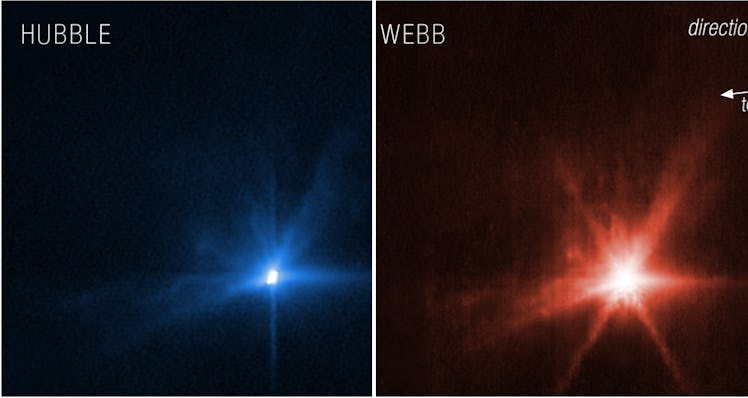NASA Hit An Asteroid On Purpose, And Now JWST Has Super Cool Photos
Following the historic DART mission where scientists hit an asteroid off its path, NASA released the first images of the collision using data from its two telescopes, the JWST and Hubble.

NASA made history last week with an out-of-this-world test. The DART (Double Asteroid Redirection Test) successfully smashed an asteroid that was nearly 7 million miles away off its path successfully. It was a major event watched worldwide, and thanks to the James Webb Space Telescope (JWST), we get a whole new look.
On September 26, 2022, DART intentionally crashed into the asteroid moonlet called Dimorphos. It was a monumental triumph in science for NASA and anyone interested in astronomy. Using a spacecraft, DART could deflect an asteroid, changing its path. While this asteroid was no threat to Earth, it allowed the technology to be tested in case that ever becomes a problem.
And even though the asteroid was 7 million miles away, there were a lot of eyes on it from outer space — both the Hubble Telescope and the JWST observed the event. And now there are pictures. According to a NASA release, the observations from Hubble and JWST were an “operational milestone,” but the data collected will allow scientists to learn more about the history and makeup of our solar system.
“Webb and Hubble show what we’ve always known to be true at NASA: We learn more when we work together,” said NASA Administrator Bill Nelson. “For the first time, Webb and Hubble have simultaneously captured imagery from the same target in the cosmos: an asteroid that was impacted by a spacecraft after a seven-million-mile journey. All of humanity eagerly awaits the discoveries to come from Webb, Hubble, and our ground-based telescopes – about the DART mission and beyond.”
NASA explains that the two telescopes pick up different wavelengths, which means they can use a more rounded dataset to evaluate essential information. With Hubble’s ability to detect visible wavelengths and JWST detecting infrared, scientists can get more of the bigger picture.
Using data from the two telescopes “will reveal the distribution of particle sizes in the expanding dust cloud, helping to determine whether it threw off lots of big chunks or mostly fine dust,” NASA explains. “Combining this information, along with ground-based telescope observations, will help scientists to understand how effectively a kinetic impact can modify an asteroid’s orbit.”
NASA has released its first images from JWST showing “a tight, compact core, with plumes of material appearing as wisps streaming away from the center of where the impact took place.” NASA shared a timelapse GIF of the 10 images the telescope captured over five hours, covering the time before and hours after impact.
The agency also released the first images of the impact from Hubble, showing “ejecta from the impact that appears as rays stretching out from the body of the asteroid.”
It will still be some time before all the data makes its way to NASA to be dissected by scientists. Hubble will continue to observe the asteroid over the next few weeks to continue collecting data.
This article was originally published on